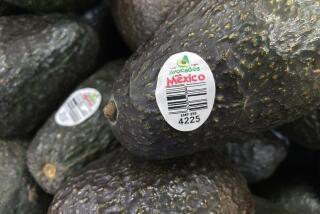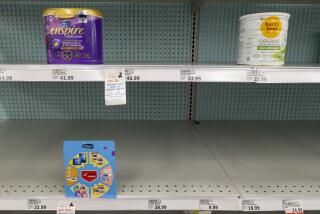Cargo inspections not enough, official says
- Share via
ABOVE THE PORT OF LOS ANGELES — The more Health and Human Services Secretary Mike Leavitt saw from his helicopter seat on Tuesday, the more convinced he was that the U.S. couldn’t ensure the safety of imports through inspections at trade gateways and border crossings alone.
Leavitt and Food and Drug Administration Commissioner Dr. Andrew C. von Eschenbach were getting their first aerial tour of the ports of Los Angeles and Long Beach on a day when China signed an agreement to prohibit the use of lead paint on toys exported to the U.S.
As the Los Angeles City Fire Department helicopter passed over Pier 400, the two were told that the single terminal operated by A.P. Moeller Maersk sometimes moves more cargo containers than any other U.S. port.
“What strikes you most is the vastness of it,” Leavitt said. “The average American simply cannot conceive of how much effort it takes to fill up the pantry of the United States every day, empty it and fill it up again. I’m even more persuaded that we cannot inspect our way to safety.”
The tour was one of several fact-finding missions for Leavitt to seaports, airports and border crossings around the U.S. It came a day after a 12-agency task force examining the safety of imported products, chaired by Leavitt, told President Bush that policing by federal agencies had failed to keep up with a rising tide of imports, leaving a patchwork system that has allowed too many defective products to enter the country.
The group was formed July 19 after toy companies had recalled products made in China.
The biggest action was by Mattel Inc., which, in three recalls, pulled millions of Chinese-made toys that were manufactured with toxic lead paint. The company also recalled toys made with small dangerous magnets.
Those were defining incidents in a year in which tires, toothpaste, pet foods and other Chinese products were recalled.
The U.S. has been fighting a losing battle at its trade gateways, the task force’s report said.
Nationwide, for example, the FDA has just 1,317 field inspectors, a Health and Human Services spokeswoman said Tuesday. They are part of the force that is trying to monitor more than 825,000 importers sending products through 300 seaports, land border crossings, postal facilities and other ports of entry.
The problem also runs deeper than having too few inspectors to monitor too many products. The federal agencies in charge of inspecting imports have a hard time communicating with each other, Leavitt said.
“An FDA inspector said he had to keep track of five passwords for five different computer systems. A customs inspector told us he had to work with seven different systems. We need to have one system, where everyone can communicate,” Leavitt said.
He added that more had to be done to monitor products at their source so U.S. officials would have a better idea of what ought to be carefully inspected.
The report contained few specifics on how such a system would work, but one FDA official offered a clue.
The official, who requested anonymity because he wasn’t authorized to speak publicly, said a database system named Predict, which was being tested in Southern California, gathered information on exporting countries, including things not usually associated with trade, such as political unrest and natural disasters. The system produces a score. One higher than 7 on a scale of 10 means that certain imports from that country need to be watched.
That seemed to fit Leavitt’s formula.
“There has to be a fundamental change from intervening at the borders when bad things happen to a focus on prevention and intervening when we know there is risk,” Leavitt said. “We can’t impede everything.”
--
More to Read
Inside the business of entertainment
The Wide Shot brings you news, analysis and insights on everything from streaming wars to production — and what it all means for the future.
You may occasionally receive promotional content from the Los Angeles Times.











